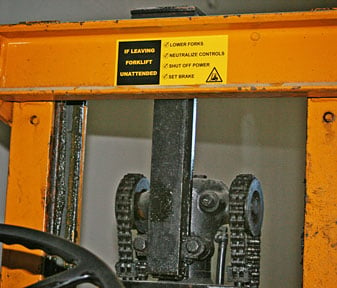The 5S System Explained: From Origins to Implementation

What Is the 5S System?
The 5S system is a lean manufacturing tool that improves workplace efficiency and eliminates waste. There are five steps in the system, each starting with the letter S:
By providing a systematic framework for organization and cleanliness, 5S helps facilities avoid lost productivity from delayed work, unplanned manufacturing downtime, and injured workers.
The Steps of 5S
5S was created in Japan. 5S meaning and the original "S" terms were in Japanese, so English translations for each of the five steps may vary. The basic ideas and the connections between them are easy to understand, though.
| Step Name | Japanese term | Explanation |
|---|---|---|
| 1. Sort | Seiri (tidiness) | Remove unnecessary items from each area |
| 2. Set In Order | Seiton (orderliness) | Organize and identify storage for efficient use |
| 3. Shine | Seiso (cleanliness) | Clean and inspect each area regularly |
| 4. Standardize | Seiketsu (standardization) | Incorporate 5S into standard operating procedures |
| 5. Sustain | Shitsuke (discipline) | Assign responsibility, track progress, and continue the cycle |
Each step in the process feed into each other to create a 5S warehouse strategy, so the sequence is important. Clearing out unnecessary materials in step 1 (Sort) will provide the space needed to organize the important items in step 2 (Set In Order). Once the workspace is de-cluttered and organized, dirt and grime can be removed in step 3 (Shine). These changes to workers' job duties and work environment should be reflected in updated procedures through step 4 (Standardize). Finally, those new procedures won't amount to much unless responsibility is assigned and progress is tracked - as required for step 5 (Sustain). With responsibility and tracking, workers will continue to apply the steps, returning to step 1.
What Does 5S Stand For?
Step 1: Sort
The first step in the 5S System is Sort, or "seiri," which translates to "tidiness." The goal of the Sort step is to eliminate clutter and clear up space by removing things that don't belong in the area.
Clearing the Work Area
For this step, take a close look at the items, tools, and materials in a work area. Items that are necessary or useful for the work being done in that space should be kept there. Everything else should be removed.
Some of those removed items will need to be thrown away or recycled. Other items might belong to another work process or location; they should be returned to their "homes." However, you might find some items that you aren't sure about.
Red-Tagging Unknown Items
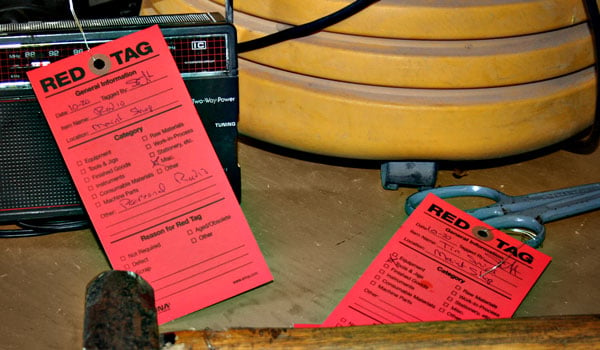
If you find an item that you can't identify, or that has uncertain ownership, it's time to use a red tag. "Red-Tagging" temporarily attaches a highly-visible tag to the item, which notes where it was found and when. Then, red-tagged items from all work areas are collected in a single location: a "lost and found" for tools, materials, and equipment.
If a work area is missing an important tool, check the red tag collection area to see if it was found somewhere else. Supervisors for each work space should check the red tag collection area periodically, in case something has been missed. Anything that belongs in a work space should be taken back there.
Reassigning Tagged Items
Items may wait in the red tag collection area, often marked with floor marking tape, for a long time. In that case, the original work area (where that item came from) doesn't seem to need it anymore. It may be useful elsewhere, though.
In one common approach, items may be left in the red tag collection space for thirty days. After that, any supervisor may claim the item for their own work area. If nobody wants it after another week, the item can be removed from the facility entirely. Sell it, recycle it, or throw it away.
If an item will definitely be needed by the company, but isn't needed right now, it might be best to store it for later. Before putting anything into storage, be sure it will actually be needed again. Have a specific plan for getting that item out of storage again, at a specific time. Don't store things "just in case" without good cause, and keep track of what's been stored. Red-tagging items is one of the countless ways to create a 5S visual factory.
Step 2: Set In Order
The second step, Set In Order, was originally called "seiton," which translates to "orderliness." A variety of names have been used in English: "Systematic Organization," "Straightening Out," and "Simplify," for example. No matter what it's called, the goal of this step is to implement 5S in workplace organization. Each item should be easy to find, use, and return: a place for everything, and everything in its place.
Building a 5S Map

Tools that are used frequently should be stored near the place they are used. Spare equipment, supplies, and other tools that are used less often can be kept in a central location, where multiple teams can share them. Items that are typically used together (such as drills and drill bits) should be stored near each other. Each of these decisions will make sense on its own, but it may become difficult to keep track of everything. It may be helpful to take advantage of 5S process mapping to create a 5S map.
A 5S map is a diagram or floor plan that provides an overview of a work area, process, or station. It provides a visual reference to show where the tools, supplies, workers, and travel paths are, and how they relate to each other. A good map may also include a description of the work that happens in the area shown. Depending on your facility's needs, you may find one approach easier than another:
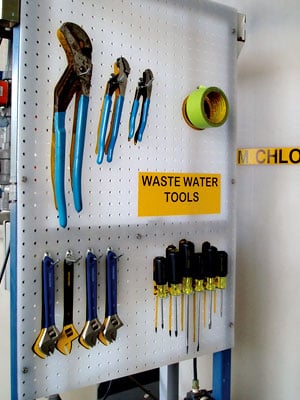 Draw up a map, and then implement it
Draw up a map, and then implement it- Physically arrange the workplace first, and then map it out
- Map as you go, testing ideas and writing down what works well
No matter which approach is used to create it, the resulting 5S map should be kept as a training tool and updated over time as the work area changes.
Communicating the Plan
Once storage locations are assigned, each storage area should be labeled. Label the outside of cabinet doors to help workers quickly identify what's inside each one. Then, label any interior shelves to show where different supplies belong. The same ideas extend to rack labels, bins, and other storage systems.
Many facilities use a "shadow board" for tool storage, to ensure that each tool is easy to put back in its correct storage place. With this approach, a label matching the shape and size of the tool is placed where that tool belongs. Workers can immediately spot where each item belongs, and know at a glance if the item is there or not. No more time wasted looking through drawers and bins.
Organization can extend to the floor, too. Work areas, movement lanes, and storage for supplies and finished products can all be marked with floor marking tape.
Step 3: Shine
The third step of the 5S methodology is Shine, or "seiso," which means "cleanliness." While the first and second steps cleared up space and arranged the area for efficiency, this step attacks the dirt and grime that inevitably builds up underneath the clutter, and works to keep it from coming back.
Routine Cleaning
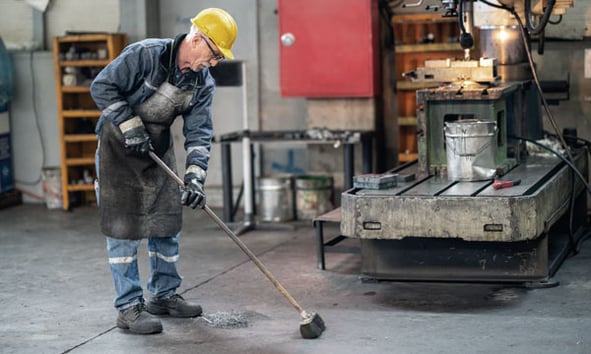
Shine moves far beyond just pushing a broom around every now and then. It involves regular cleaning of every part of the work area - often a daily wipe-down, and a more thorough cleaning each week.
Importantly, the Shine step is not meant to be a job for the maintenance or janitorial staff. Each worker should clean their own work area, and the equipment they use. This approach has several benefits:
- Workers who are familiar with the area will quickly notice any problems that arise
- Hazards or difficult situations will be understood and accounted for
- Items that are out of place or missing will be recognized
- Workers will tend to keep their own workspaces cleaner during normal operations
Everyone should pay attention to the overall cleanliness of the workplace, being willing to pick up trash and so on. But for the this process to give the best results, each worker should take personal responsibility for their own working space.
Shine as Preventative Maintenance
Keeping work areas clean will have many advantages. One important advantage is that it's easy to spot leaks, cracks, or misalignments. If the people keeping the area clean are the same people who work there regularly, they will be quick to recognize any of these problems.
Leaving those problems unnoticed and unresolved could result in equipment failure, safety hazards, and loss of productivity. With the constant cleaning and inspections used in the Shine step of the 5S principles, the system can feed into a preventative maintenance program. This way, 5S can extend the working life of equipment and help reduce emergency downtime.
Step 4: Standardize
The first three steps of 5S cover the basics of clearing, organizing, and cleaning a workspace; on their own, those steps will provide short-term benefits. The fourth step is standardize, or "seiketsu," which simply means standardization. By writing down what is being done, where, and by whom, you can incorporate the new practices into normal work procedures. This paves the way for long-term change.
The Power of Writing Things Down

It's been said that "If it isn't written down, it didn't happen." Writing down the decisions that you make in your 5S program will help ensure that your work doesn't just disappear. If you made a 5S map in the Set In Order step, that map can be part of your new standard for the area. In the same way, the process that you use for red-tagging items can be written down and included in the standards.
Writing out your decisions doesn't mean you can't change your mind, though. The purpose of the 5S methodology is to make your workplace better, not to make it unchangeable. You are writing the standards for your facility, and you can change them to fit new information or new business needs.
Tools for Standardizing 5S Methodology
Once you've made decisions on how to change your work practices, those decisions need to be communicated to workers. This communication is a key part of the Standardize step. Common tools for this process include:
- 5S checklists: Listing the individual steps of a process makes it easy for workers to follow that process completely. It also provides a simple auditing tool to check progress later on.
- 5S color coding chart: Visually organize tools, materials, and workspaces with designated colors to enhance efficiency and safety in the workplace.
- Job cycle charts: Identify each task to be performed in a work area, and decide on a schedule or frequency for each of those tasks. Then, assign responsibility to a particular worker (or job duty). The resulting chart can be posted visibly to resolve questions and promote accountability.
- Procedure labels and signs: Provide operating instructions, cleaning steps, and preventative maintenance procedures right where that information will be needed.
Step 5: Sustain
The fifth step is Sustain, or "shitsuke," which means "discipline." The idea here is continuing commitment. It's important to follow through on the decisions that you've made - and continually return to the earlier steps of 5S, in an ongoing cycle.
Never "Once and Done"
The 5S approach was never meant to be a one-time event, but an ongoing cycle. This is key, because early successes in implementing these lean manufacturing principles can open the way for problems. If open space becomes available in the Sort step, but afterward, tools and materials are allowed to gradually fill in that space without any organization, the end result can be an even bigger mess. The solution is to apply the 5S principles over and over, as a routine part of normal work. That's why Sustain is so important.
Sustaining a 5S process can mean different things in different workplaces, but some elements are common in successful programs.
|
|
|
|
|
|
|
|
|
Sustain Is Not the End of 5S
While it's the last step in the sequence, Sustain is not the end of the 5S methodology as a whole. One pass through the steps can expose problems that were hidden beforehand. Following the steps again can resolve those problems, and help discover new ways to improve. Continue through the cycle again and again to keep your facility at the top of its potential.
A Sixth "S" for Safety
When it comes to lean manufacturing and workplace improvement, the 5S principles is one of the most widely known and used lean tools. It's no surprise: this process can increase workplace efficiency, reduce costs, and improve quality. But with many lean programs, it's easy to focus only on those goals, and lose sight of the human factor. Worker safety is critical. That's why many facilities add another step to the 5S cycle, calling the result "6S" - with Safety.
Unlike the first five steps, Safety is not a sequential step. It must be considered during each of the other steps. During the Sort phase, for example, you might decide that a given tool is obsolete because a newer version is safer to use. Likewise, during the Standardize step, work procedures need to be standardized to improve workplace safety, not just efficiency.
Keeping workers safe isn't just the right thing to do: there is a hefty monetary cost for accidental workplace injuries. A study by Stanford University found that the costs for a bone fracture can cost a company $50,000 up front, as well as another $55,000 in indirect costs. Each incident can lead to an OSHA inspection and citations, as well as an increase in insurance costs.
(Source: The REAL Cost of a Workers' Compensation Claim, Jeff Cavignac)
Choosing to implement 6S, instead of the standard 5S program, can help you improve workplace organization and efficiency, while also making the workplace safer.
Benefits of a 5S Program
Because 5S focuses on improving a workplace, and different workplaces may have little in common, it can be hard to predict the exact results of using the program. However, some benefits are almost always found:
|
|
|
|
|
|
|
|
|
|
|
These benefits are not just good feelings. By documenting their situations before and after adopting 5S, many facilities have been able to show actual, measured improvements. Implementing the 5S methodology has been associated with notable improvements in workplace efficiency. For instance, a study by International Journal of Innovative Science and Research Technology highlighted that efficiency improved from 67% to 88.8% following successive 5S activities.
These facilities aren't just warehouses either, 5S-incorporated medical facilities benefit greatly from implementing the system as well.
For example, a hospital used the 5S process to reduce setup time in operating rooms by 37%, and reduced the number of tools needed for some procedures by 70%. On the financial side, the hospital realized savings of about $2.8 million per year. (Source: Journal for Healthcare Quality. September/October 2015. Volume 37, Issue 5)
Dive Deeper into 5S with DuraLabel Solutions
Whether you need safety signs, pipe markers, or equipment labels—Toro Max and Kodiak Max are ready to transport anywhere you are. Get help crafting a system that will provide the safety communication you need. Call 1-888-820-4631 and one of our experts will guide you through the process.
Learn more about lean tools that can be used to help create an environment where changes are accepted and business practices are continuously improved upon. Download our free 5S Quick Start Guide.
Read Next:
Tips for Choosing the Optimal Floor Marking Tape
Related Resources

Lean Manufacturing and the 5S System
What is 5S in Manufacturing? 5S is a lean manufacturing method used to eliminate waste, improve workplace ...
Read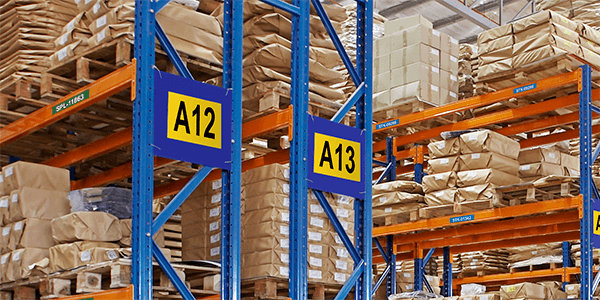
5S Examples in Action: The Good, the Bad, and the Successful
Can 5S Improve Efficiency and Engagement Across Industries? The 5S systemis a proven method for improving ...
Read
Creating a Visual Factory with the 5S System
What Is a Visual Factory with the 5S System? The term "visual factory" refers to an approach to lean ...
Read.png)






